Sony WH-XB910N Teardown by 52Audio
I was hoping we would see a teardown of the WH-XB910N, and 52Audio delivers once again. I will try to go over anything interesting and do a quick comparison to the older WH-XB900N. Perhaps some of these new changes could make their way into the upcoming Sony WH-1000XM5.
Aside from the design differences between the WH-XB910N and XB900, one nice feature is that the new model comes with a physical case, similar to the WH-1000XM4, where as the previous model came only with a pouch.
So time to look at the teardown, starting with the right side. To remove the ear cushion, you will need to unlatch the plastic clips that attach them to the main body. To unlatch the plastic clips, one has to gently squeeze the outer edge of the cushion frame in order for the plastic clips to let go. Be careful when squeezing the plastic, since too much force might break the clips or the frame.
In this next photo, the holes where the plastic clips can be clearly seen. By gently squeezing the outer edge, the clips should come out and the cushion detach. If the frame or too many clips break off, or the cushion is damaged, replacement pads can be ordered from Sony, but they might not be that cheap. Personally I would order a black pair for the blue model as it would look kind of cool.
Unlike the previous model, the new model has hybrid ANC, meaning feedforward and feedback microphones. This should result in much better NC performance and maybe even on the same level as the WH-1000XM4.
Here we can see the feedback microphone. The cover is composed of rubber silicone. The WH-XB910N has switched over to a MEMS microphone, where as the WH-1000XM4 uses an electret microphone, and covered by a plastic cover. Perhaps the WH-1000XM5 will also switch to a MEMS microphone and rubber cover. I dd notice there are now 4 wires coming off the MEMS microphone compared to 2 on the WH-1000XM4 electret microphone. Anyone know what the extra wires could be for?
Looking at the driver, it is 40mm as per specifications, and identical to the WH-XB900N.
Removing the driver and the plastic surround on the right side reveals the following:
We have the touch sensor PCB, the feedforward microphone on the right in the photo, and the small board which has the connections for the driver, both NC microphones, the touch sensor, and for the battery. The NC microphone is under the black cover and an electret type (see below). The microphone is held in place in a silicone enclosure.
A close up of the board with all the connections.
- Battery pack connector
- Feedforward NC microphone
- Driver unit connection
- Feedback MEMS microphone
- Touch sensor ribbon
- Cable with all wires connecting to the main PCB on the left
On the small PCB is one main chip, the Microchip PIC16LF1509-I/ML main controller chip.
Next up looking at the battery, which is supplied by Springpower Technology. The exact same battery, 520mAh/2.0Wh 3.85V, is also found in the WF-1000XM4 charging case. The battery pack uses a connector rather than being soldered to the board. The connector is the same one as the WF-1000XM4, so I assume the battery pack assembly is identical to the WH-XB910N.
The previous model had a much larger battery capacity, 1000mAh 3.7Wh 3.7V, but it did also employ a much older Qualcomm CSR8675 Bluetooth chip, along with Sony's own CXD90050 (QN1). When comparing available operating times, LDAC with NC on is the same, up to 25 hours. Next I compared the NC off operating times for both models, but only the WH-XB900N shows DSEE off in the manual, so I hope the DSEE would also be off in the WH-XB910N. The older model can get up to 30-35 hours of playback where as the new model can achieve up to 50 hours, so even if DSEE is on for the WH-XB910N, the playback time is pretty impressive considering the smaller battery capacity. Of course the newer model has a much more power efficient Bluetooth SoC and newer components which no doubt use less power.
Imagine if Sony used a slightly larger battery size, like 600mAh or 750mAh, the battery life would be incredible. For the rest of the right side teardown, see the original link.
The WH-1000XM4 uses a 1100mAh 4.1Wh 3.7V battery, with the new model moving to a 3.8V battery, but unknown capacity. If Sony switches to the MT2822 SoC, then I think the battery capacity might be dropped to save on weight but with the more power efficient chip, battery life will be on par or better than the current model.
Moving now to the left side of the unit. Removing the earpad is the same steps as before, gently squeezing and taking it off. The plastic cover is similar to the right side minus the section for the battery pack.
 |
| Click on the photo for larger size |
Looking at the inside, we can see the voice microphone in the top right of the photo beside the 3.5mm jack, and the feedforward microphone on the left under the plastic cover. The 52Audio teardown labels the microphone near the 3.5mm jack as the microphone used for noise reduction, but this is the voice pickup microphone.
Moving onto the left side main PCB, we have the following connections:
- Voice microphone
- Feedback microphone
- Main driver
- Feedforward microphone
- Connections from the right side wires
- Bluetooth antenna
While hard to make out, #5 also contains 2 thicker wires on the lower right side, black and white. These appear to be the wires from the battery from the right side PCB. Unfortunately the foam covers the connection, but the FCC filing does have the PCB without the foam, but no cables (see below). The black cable looks like it is for the negative terminal and the white one for the positive.
I have pointed out the 2 cables, black and white and added the FCC photo that displays the positive and negative terminals. I am assuming this is what they are but I could be wrong. We can also see a POSCAP capacitor under the connection.
Finally we get to the 2 chips on the other side, the main Bluetooth SoC and the flash storage.
The main Bluetooth SoC is the Mediatek MT2822SA. This is the same SoC found in the WF-1000XM4 and the new LinkBuds. Just like the WF-1000XM4, the WH-XB910N also has extra flash storage on the board, the same chip even, the Q128J, which is 128Mb of storage. If the MT2822 is just a custom Airoha AB1568, it already comes with 64Mb of flash storage on the chip, but I guess this is not enough for Sony and the firmware.
I thought this might be related to the LDAC codec, since both the WF-1000XM4 and WH-XB910N both support it, but the WH-XB900N also supports LDAC in addition to aptX but it only has a 64Mb flash chip.
We have about 3-4 months before any possible leaks of the WH-1000XM5 start showing up. I am sure some of the changes seen in the WH-XB910N will make their way to the WH-1000XM5, like the MEMS microphone for the feedback microphone and possibly even MEMS for the feedforward microphone as well. Sony already uses 3 MEMS microphones for the voice pickup on the WH-1000XM4, so I do not expect this to change.
So that is the teardown, link for the full teardown at the end of the post.
Source: 52Audio



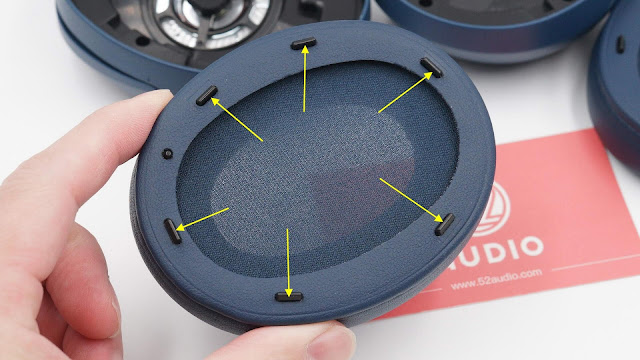
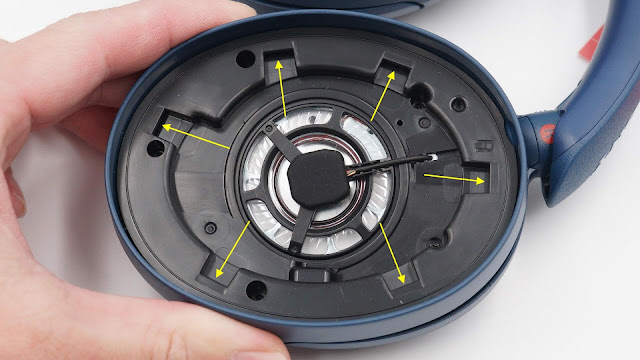




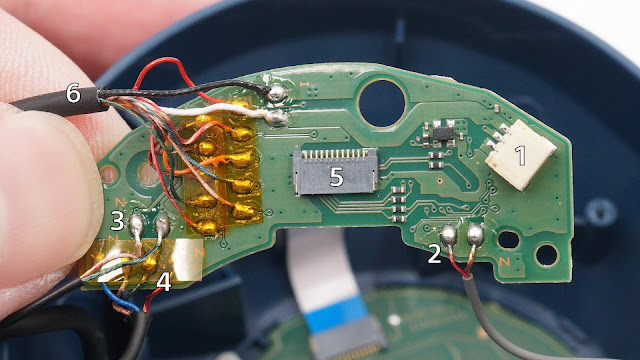


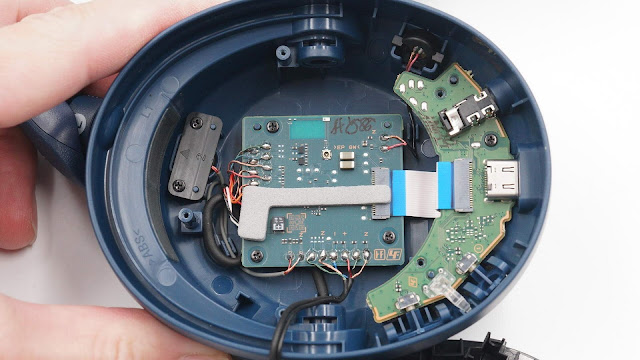
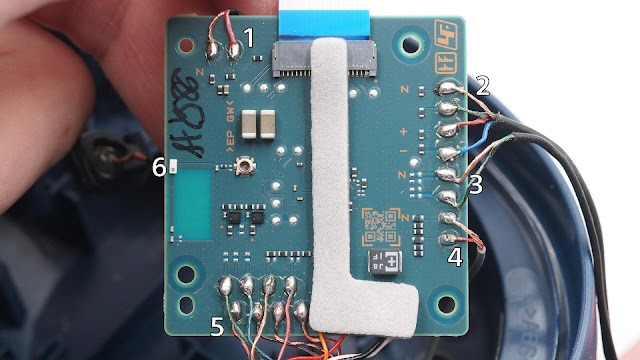

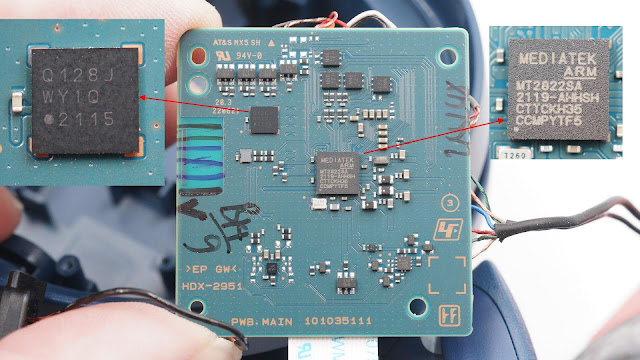

The change to a MEMS microphone only for feedback is interesting.
ReplyDeleteI believe it's to reduce perceived white noise with ANC caused by miniaturisation of the microphones.(low SNR) On the XM4 when you hold the power button longer than usual(as you'd do to start pairing) there is a bug where the feedback microphone is not used by the ANC for a few seconds or until the button is released, this way it's possible to hear just how problematic having two microphones can be for ANC.(more noise)
But maybe i'm wrong. Then again there are the 4 wires, possibly a sign of the desire to get lower noise out of the MEMS. Just why mix two types? How does it compare against WH1000 series in inherent ANC noise? so many questions...